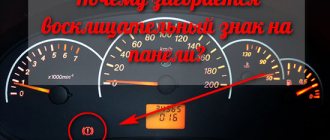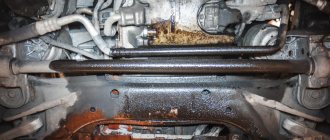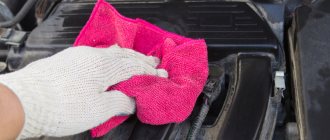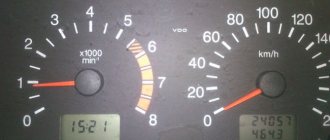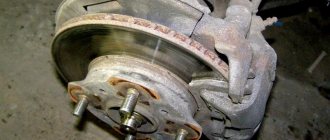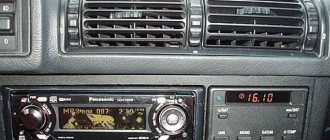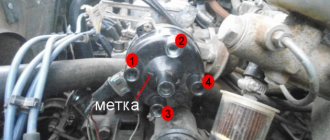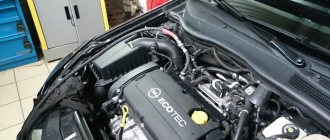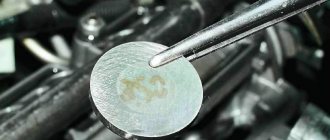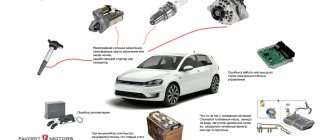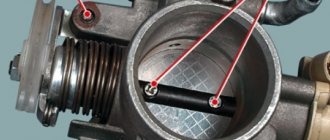Many car enthusiasts, seeing that the ABS light comes on on the dashboard, begin to suspect problems with the brakes and strive to fix them as quickly as possible. But this opinion is wrong: such a signal indicates a malfunction of the anti-lock system. In such a situation, it is important to correctly determine the cause of its occurrence. Sometimes you can do this yourself, but most often you cannot do without computer diagnostics.
What to do if the ABS light is constantly on and does not go out?
Why does the ABS light even come on?
In a normally running vehicle, this indicator shows you that the wheels have been unlocked. In this case, everything works fine, the sensors sensed the need to turn on the safety system, initiated its operation and demonstrated to the driver that some assistance was provided when braking. When you see the ABS light on while braking, it is better to release the brake pedal a little and take over control of the car. If you have an expensive, high-tech car, you can trust the well-thought-out systems and let ABS+EBD do the job. In other cases, the light may be on for the following reasons:
- the sensors are clogged, the on-board computer indicates that the diagnostic error code should be read;
- Dirt or rust got on the sensors, which caused the anti-lock braking system to turn on incorrectly;
- there is a problem in the on-board electrical system, which is demonstrated by random lights coming on;
- the wheel bearing has failed, which forces the sensors to constantly turn on the anti-lock braking system by mistake;
- the fuses in the unit responsible for the ABS system have failed and are passing the signal directly;
- There was an error in the computer that caused the ABS light to come on.
Also, sometimes troubles occur with the generator and other elements of the machine’s electrical circuit, which can result in the lighting of the diagnostic system light or warning lights of any type. For example, on a Volkswagen car produced in the 2000s, the anti-lock braking system light comes on even if there is an error in completely different components. Therefore, self-diagnosis is only a partially acceptable method of solving the problem, because often the driver does not have special tools at hand for a good investigation.
How the system works
The anti-lock braking system performs its work cyclically, with each cycle consisting of three phases:
- Pressure increase (by driver). Braking occurs in normal mode, the pressure in the system increases as the driver presses the brake pedal. The inlet valves of the valve body are open, the exhaust valves are closed. If the wheel speed slows down too much and exceeds a certain value, the ABS control unit moves the intake valve to the “closed” position, and the exhaust valve is also closed. The system moves to the next phase.
- Holding pressure. At this stage, the ABS system, as it were, “cuts off” the main brake cylinder from the braking process, and a constant pressure is maintained in the “hydraulic unit - wheel brake working cylinder” circuit. Even if the driver presses the brake pedal further, the pressure will not increase. In this mode, braking occurs at maximum braking force, that is, most effectively. The control unit continues to monitor the speed of rotation of the wheels, and if it decreases below the permissible threshold, that is, there is a threat of wheel locking, a command will be sent to open the exhaust valve and relieve pressure.
- Pressure release. During this phase, the exhaust valve opens and the pressure drops sharply. First, the liquid enters the hydraulic accumulator, then it is pumped back to the GTZ by a pump. The inlet valve remains in the closed position. After the wheel deceleration speed returns to acceptable values, the exhaust valve closes. The intake valve opens and the cycle begins all over again.
This cycle of operation of the vehicle's anti-lock braking system is repeated until braking is completed, and can be repeated approximately 6 times per second. Note that ABS is activated during emergency (sharp) braking. It is impossible to disable the ABS system without interfering with the car's design, since stopping its operation can lead to tragic consequences (therefore it is not provided for by automakers).
Note that ABS is integrated into the standard braking system of the car without changing it structurally. If the vehicle's anti-lock braking system is faulty, the corresponding indicator (warning lamp) will light up on the instrument panel.
What other reasons could there be for such an error?
You need to take into account the specific design of the security system in your car. In particular, there are complex ABS systems that can fail and require complex diagnostics using proprietary equipment. Sometimes the problem is completely related to the failure of other parts. It is important to understand this in order to take into account all the features of a possible problem and fix it without problems.
It is worth considering the following possible situations:
- Failure or “glitch” of the ABS control unit. It happens very often on modern cars and requires replacement or complete reflashing of the unit at a good station.
- The on-board computer malfunctioned. A certain glitch may have occurred in the car control program, which caused such an error to appear. The light comes on and goes out or just stays on, but everything works fine.
- The fuse of one of the control systems has blown. This could be a fuse responsible for the operation of ABS sensors, for example. It is necessary to diagnose the electrical network to find the necessary parameters.
- Problems with other sensors and the power grid in general. Problems with the vehicle's electronics and wiring may well cause the ABS light to come on. A competent diagnosis will help to cope with the problem.
Whatever causes this lamp to light up, you shouldn’t just turn a blind eye to it. It is better to find out what exactly is the reason and fix the problem. Perhaps it's a simple wiring break, but it could be much worse. It is better to carry out diagnostics at a proven service station, which guarantees high quality testing of each unit. Self-repair is only possible in some cases. The electronics of a modern car are very difficult to understand, even with experience and tools.
ABS valve body repair
If you have checked all electrical elements, connections, contacts, sensors and fuses, and made sure that the control unit is not damaged, then you need to become more familiar with the valve body. We left it until the end because this part is mechanical and difficult to diagnose without removing and disassembling it. On all machines, hydraulic blocks are located in different places, but usually access to them is not the easiest; you have to disassemble a lot around to get to the block itself and dismantle it.
The photo shows the ABS valve body of a BMW 3-Series 1995. The valve body has two main faults - the electric motor and general contamination. The electric motor either runs out of brushes or the winding breaks. If you managed to get to it and remove the motor from the valve body (usually this is not a task for the faint-hearted), then repairing the motor itself is not difficult, no more difficult than rebuilding a generator.
ABS valve body brushesCleaning the valve body (if you managed to disassemble it) is also not the most difficult task. The unit can become very rusty and clogged with dirt (especially important for cars where it is located very low and dirt from the road flies onto it), so WD-40, brushes, rags and off you go. The task is painstaking, but simple - it will be more difficult to put everything back together later.
Rusty ABS valve body motor Unlike sensors, there is an economic sense in repairing valve bodies - new ones cost from about 20,000 rubles to infinity, and the breakdown can be in cheap motor brushes. True, there is a third option - look for a unit at a disassembly site; often you can buy a part there relatively inexpensively, but at the same time you won’t have to deal with the most simple repairs yourself.
With the ABS system, everything is ambiguous - if the diagnostic lamp lights up or blinks, then it can be either a cheap fuse or an expensive valve body. What exactly is broken will have to be looked for and found out. If you have the strength and ability, repair it yourself; if not, go to a service center, but it’s better not to bother with a burning ABS light.
It just seems that the system is not particularly needed, without it the car still drives and even brakes, but ABS is created for extreme situations. It is no coincidence that even in our country, where, to be honest, safety is not the first thing they think about, it has been made mandatory. She may be able to save you and help you avoid injury.
If the ABS light comes on on the dashboard of your car, then you should not panic ahead of time. There is no particular fear in this, the problem is not serious, and its elimination in most cases will not require serious financial investments.
[custom_ads_shortcode3]
What can you check yourself if the ABS light comes on?
The first thing you can do on your own in such a situation is to go to a car wash and ask for a good wash of the rims. Often, this intensive pressure washing can clean the ABS sensors located near the brake discs. On your way to the car wash, you can perform another simple test. Accelerate to a speed of 80-90 kilometers per hour, close the windows and turn off the music. If in this driving mode you hear a slight or annoying hum in the area of the wheels (front or rear), the likely cause of the light is a failure of the wheel bearing. There are several other things you can do:
- inspect the fuse box and replace the module that is responsible for the operation of the anti-lock braking system;
- if possible, read the diagnostic error code and read about it on the forums;
- to a specialist, describing your situation, and then try to correct the error yourself;
- get to the ABS sensors yourself by jacking up the car and removing the wheels to check their cleanliness;
- inspect the electronic control unit located under the hood, check that there is no liquid in it or on it;
- the best solution is to go to a service station and pay for diagnostics of the car's anti-lock braking and electrical systems.
The last step will definitely be the most correct, since you will receive a clear answer to your questions, you will be able to determine the repair budget and the presence of serious problems. This is the only way to completely get rid of problems with the diagnostic system light on and other unusual behavior of the car. It is enough just to connect computer diagnostics with an advanced program and test the car for possible errors. Within a few minutes you will receive the necessary information and can begin to fix the problem yourself or professionally.
Disconnection procedure
And yet, if you are determined, in this material we will tell you how to disable ABS on a Priora. The algorithm of actions in this case is as follows:
- first of all, you should open the mounting block, which is located near the battery;
- Turn on the ignition for a short time, while the ABS and brake indicator lights should not go out. A beep will also be heard;
- turn off the ignition;
- Unscrew the mounting block and remove its bottom cover;
- find the wire leading to the previously removed fuse, cut it lengthwise and strip the bare ends by 1.5-2 centimeters.
First you need to purchase a simple relay with five contacts. It is also recommended to carefully study the contact diagram. After all of the above steps have been completed, you have to find contacts numbered 85 and 86, which go to the winding.
The wire going to ground should be connected to them, the second one will be needed to send a signal from the ignition switch through the toggle switch that turns off the ABS.
Contact number 30 must be connected to the wire that comes from the fuse, and contact number 88 must be connected to the ABS. It is more convenient to do this by having pre-prepared conductors on hand, crimped on one side with a “mother” terminal. After this, they must be installed in the empty relay block, and the switch off button can be mounted at your discretion in any convenient place inside the car. In the future, during operation, you should carefully analyze changes in the properties of the car while driving. To do this, you can monitor the driving characteristics in comparison with those that were previously, which is not difficult for experienced owners, and also control the speed using the speedometer.
To summarize, it is worth noting that the process of disabling ABS on the Lada Priora, as well as on other brands of cars, is not complicated, and theoretically, any owner can disable it independently. At the same time, I would like to remind you once again that disabling ABS independently carries certain risks, in particular, an increase in braking distance in bad weather conditions, as well as difficulties in the process of repairing and servicing the car, including if it is in warranty period.
ABS turns on randomly, the light blinks or lights up periodically
One of the most difficult forms of breakdowns is the constant blinking of the ABS light. This means that the anti-lock braking system sensors send incorrect signals to the computer, which, in turn, issues other incorrect commands to the vehicle's systems and modules. In such cases, many people prefer to simply turn off the anti-lock system, since unpleasant incidents may occur. For example, turning on ABS at a speed of 90 kilometers per hour with light braking can damage the chassis of the car and contribute to a complete loss of control over control. It's better to do this:
- bring the car to a service center for diagnostics, find out the reason for the chaotic operation of the equipment;
- for domestic cars equipped with a primitive anti-blocking device, it is better to immediately disable the system;
- complex designs and on-board electronic systems of foreign cars will have to be reflashed for repair;
- on some machines it will be easier to find the problem and fix it than to disable the anti-lock;
- you need to keep in mind that this particular system is not always the cause of the ABS light coming on; the problems can be different;
- During the diagnostic process, it is better to check the entire on-board electrical system and equipment.
By paying a certain amount for a car inspection, you can get the right answers to important questions. Sometimes a light that comes on on the panel can develop into a full-fledged repair of important units and components of the car, so you will have to spend a lot. But in most cases, this problem is not so expensive to solve. The cost of repair work depends, of course, on the make and model of the car, and on the price of spare parts. If an ABS sensor for a domestic car costs from 600 rubles, then a Japanese SUV will cost more than 10,000 rubles to replace one such sensor. We suggest watching a video about solving a similar problem using computer diagnostics:
Let's sum it up
Problems with ABS are not very pleasant incidents in any case. It is better to stay away from various problems and try to operate the car according to the requirements and advice of the manufacturer. But sometimes this turns out to be impossible, so it is necessary to have a good service in mind that can help in different situations. By contacting an official service center with this problem, you may become a victim of an overly scrupulous approach to diagnostics and incur huge repair costs.
However, sometimes the problem with the ABS sensor and the light on this system can be solved independently. Use the tips described above in the publication to understand all the features of a particular troubleshooting method. We warn you that it is impossible to completely disable ABS yourself. The on-board computer will either simply not allow the car to start, or will begin to behave inappropriately, producing new diagnostic system error codes each time. Have you encountered incorrect operation of ABS sensors and a constantly burning light?
Behavior of a car with and without ABS
As you can see in the pictures, how a car behaves with a working ABS and a non-working one or without ABS. During a slide, ABS helps leave control of the car in the hands of the driver; without ABS, the car behaves in the direction the inertial force pushes it.
0
Author of the publication
offline 1 week
